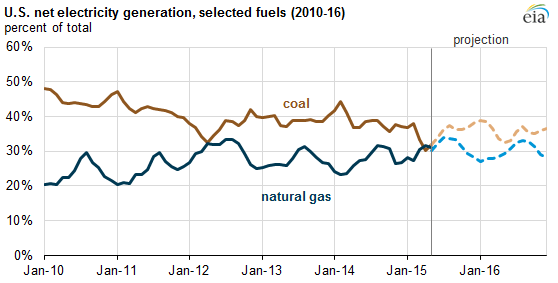Have questions or need help? Give us a call: 1-(888)-364-9259
Electricity Rates and Generation Fuel Mix -
Residential electricity rates are largely dictated by power generation fuel costs. The United States boasts a diverse generation fuel mix. In 2013, electricity was sourced from coal (39%), natural gas (28%), nuclear (19%), hydroelectric (7%), and renewable (6%) generation resources. However, electric generation sources vary widely across the country.
Washington State, for example, produces about 68% of its power from hydroelectric sources. Tennessee, on the other hand, relies on coal for 68% of its power while nuclear generation is responsible for 56% of Connecticut’s electricity. The only consistent truth across the country is that the generation fuel mix is changing.
The general changes in fuel mix are an increase in both natural gas and renewable energy generation. The development of shale gas reserves using hydraulic fracturing techniques has dramatically increased natural gas supply and kept prices at historically low levels. Renewable energy generation, primarily in the form of wind and solar resources, has also been growing at an incredible rate.
Coal-fired generation, however, has been steadily declining as concerns about the environmental impact of combustion gases have received more attention. Renewable energy, however, is not necessarily a good substitute to pick up the slack from coal plant retirements. While wind and solar power are becoming more economical, they are limited in the amount of baseload generation they can offset. Baseload generation is essentially the around-the-clock fundamental consumer demand for electricity.
Solar power provides additional power during peak usage times but it is limited by daylight and weather conditions. Coastal wind generation is useful for peak power while inland wind generation is great for power generation during evenings and nights when solar power is not available. However, natural gas is the best alternative to coal when it comes to baseload power generation.
Similar to coal-fired generation, power plants using natural gas can operate around-the-clock in virtually any weather scenario. In addition, combined cycle combustion turbine technology has resulted in a highly efficient conversion of natural gas to electric power with minimal discharge of greenhouse gases.
The U.S. Energy Information Administration reported that in April 2015 the generation of electricity by natural gas exceeded coal-fired generation for the first time since it began tracking those statistics in 1973. While this was only a one-month phenomenon, it signals the growing importance of natural gas in the national electric generation fuel mix.

Source: U.S. Energy Information Administration
Coal-fired generation is expected to continue to lose market share to natural gas. Increases in the cost of resource recovery are making coal a less economical fuel source for electricity. While the long-term effect on electricity rates depends on a number of variables, abundant natural gas reserves and clean-burning generation technologies should keep rates in check for the near future.